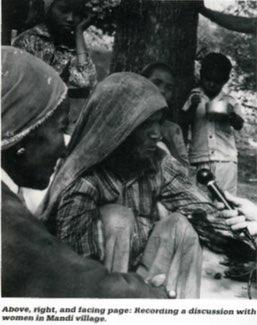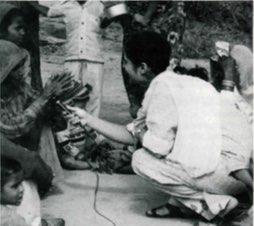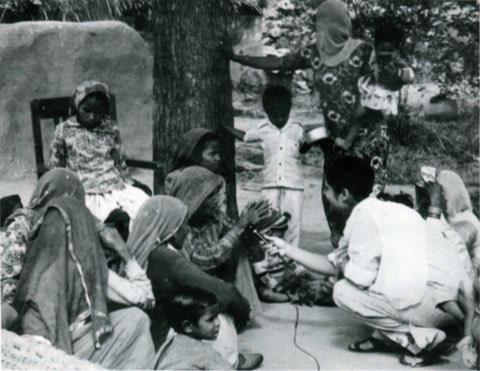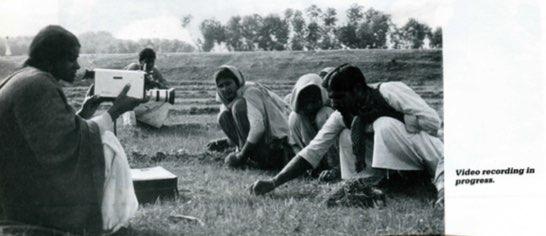CENDIT/India
Akhila Ghosh
The Centre for Development of Instructional Technology (CENDIT) is concerned with the role of communication in development and has produced several video programs on women's issues. It has been actively associated with the use of media in women's action and provides training to activists in video production, poster making, production of slide-tape shows and other media.
Akhila Ghosh shares the experience of CENDIT in using media with rural women as well as the results of a study carried out on the use of government-made films on family planning among rural women in northern India, specifically in Uttar Pradesh and Haryana.
The films shown to our rural audience were selected from about 100 films made by the government-owned Films Division, to represent thematic and stylistic variety. Persuasive techniques for birth control used several different arguments, some highlighting the economic aspects, some the welfare of the family in general and the children in particular, and some the health of the mother (and consequently, of the child). Talking to the makers of these films, certain points emerged. They are more or less in a vacuum. The nature of the "rural audience," their aspirations and attitudes is not quite clear to the filmmakers. No personal experience or research study informs them, nor is there any systematic feedback after showing the films. How could these centralized films, made from urban centers, dubbed in over a dozen languages, to be released through theaters in urban and semi-urban areas, cater to any "target audience"? And yet, one of the most important points thrown up by our field research was that familiarity of culture as expressed through language, environment and behavior of characters in the films, was one of the strongest inputs, for a film to be credible and for its message to be taken even somewhat seriously.
Our effort to elicit response to our questions from the women aroused, very often, a peculiar kind of amusement. The women themselves giggled when asked to make specific comments on the films; the men on the other hand thought our questioning was useless: "Ye dhor hain (they are like a herd of cattle), what do you want to do, going about asking them questions? They don't know anything." It was in this kind of atmosphere that we tried to examine, through patient and prolonged conversations, what reaction the women had to these films on family planning.
The women would say to us, when ultimately they opened up, that these are only films; very nice – chalti phirti tasveer (a moving picture) but it is not real, it is only a screen. When we said that they were pictures of real people, the photographic process was difficult to grasp - What are "pictures of real people"? You don't have posters and wall paintings of real people. Second, it was always asked - well, how are they real, they don't dress like us, they don't behave like us. So real meant credible. For instance. Actual Experience, a film featuring frank interviews with women having used the lUD was almost rejected outright. The reason: How can we trust such women? They have no shame, talking about such problems in front of the camera. We wouldn't do it. And they are so unlike us in every way. This film was one of the rare ones actually meant for rural audiences - as a testimonial for the use of the lUD - and featured a mixture of urban and rural women from different regions. This mixture was perhaps one of its problems - without local color, there was never the required response. Teen Saal Baad (Three Years Later) was a mentionable film. Tender and evocative, set in semi-rural settings, the film tried to show that for a woman's health a gap of three years between children is necessary. Perhaps because of the rural setting and the language, this film evoked at least some curiosity and touched the women's hearts. However, even here, some of the reactions of the men were horrifying, to say the least. Asked to comment upon the incident in the film where a woman loses her child and her own life through repeated pregnancies, many of the men interviewed either dismissed this possibility with disbelief or were callous enough to suggest that another wife could always be found.

So what were we trying to do? Persuade women to adopt family planning methods? Did the decision, even to think, and then to act, lie with them? Those women at the reproductive age - what was their status as daughter-in-law in the family, and in the village into which they married? Any attempts to introduce birth control or health improvement measures in isolation, exclusive of social education efforts, are bound to fail. And it is important for media makers to remember that messages and the way they are conveyed relate to the psychological and cultural background of their viewers.
Combining Traditional and New Techniques
Raja Bhoj (King Bhoj) was a CENDIT film made on the basis of our experience and the thinking suggested by others' work in similar areas. It was an adaptation to film of the traditional svaang (parody/irony) form of theater prevalent in Haryana and Uttar Pradesh. The technique of adaptation was guided by two objectives: the first was to retain the major identifying characteristics of the svaang, like its structure of dialogue and song, movement and pause, its peculiar circular movement of principal actors in exposition of dramatic moments, and the style of the music, including dialect, melody and musical instruments. The second was to use to advantage the possibilities of the film medium: the use of women performers, appropriate, though simple, changes of location, use of cinematic devices like close-ups and editing patterns that heighten intensity, clarify and emphasize selected information, and cut down time transitions.
Raja Bhoj is a traditional tale, highlighting a woman's strength of character through the rather adventurous and romantic portrayal of a low-caste girl challenging a king and finally becoming his queen. Family welfare arising out of the adoption of a small family norm is sung by the royal couple as a regal testimonial at the end. This film was shown extensively in rural areas in U.P., Haryana and Rajasthan over a long period, and is still remembered, complete with songs and some appreciation of its message.

How Can We Evaluate Audiovisual Media?
But is this what the film was expected to do? Be "remembered with some appreciation of its message"? What kind of evaluation brings us to this conclusion? What can we expect of audiovisual media and how do we assess its potential, determine its use, and evaluate its effect? We believe in the use of such media for social change. But society or social thought exists at so many levels that change must also operate at so many levels. Behavioral change is the last index. It must usually be preceded by change of attitude, sometimes due to information gain or a reperception of one's own attitudes and benefits accruing from them. However, evaluation research techniques concern themselves with finding out in a somewhat cursory way, behavioral change, and that too, by a quantitative assessment. We have found conventional methods of evaluation often inadequate in technique and fallacious in approach, giving a wrong picture. Nor can any such evaluation claim, as it often does, to be complete, authoritative, or even reliably objective. It requires a patient intelligence, in-depth probing over a range of perceptions and reactions to a media program, and also a "participant observer" approach - that is, involvement, to give us a "true" rather than an "objective" picture. And yet the need for media makers and users to be alert to the effect of their products on their audience cannot be emphasized too much. Most often, media is used blindly, with no prior or later understanding of its effect on its audience.
Overcoming Communication Barriers
Using video in a rural situation was like magic, at least, as far as overcoming certain communication barriers faced with respect to film are concerned. Portable video equipment is characterized by its flexibility and ease of operation in field situations. It is also free of the problem of processing. Video pictures and sound are played back immediately. This immediacy affects the user of the equipment, the audience and the quality of the program itself. The polished refinement of art does not distract us as such refinement is not technically possible. This very "limitation", allows the media and its maker to share the rough nature of the problems it explores. Immediacy affects the audience as they see themselves instantly — the medium becomes credible. If they can see themselves in their own environment reflected on the screen, it is possible to believe that this screen tells the story of others like themselves, real and suffering, in other places and situations. Such immediacy also effects the spontaneous quality of response and therefore, evaluation. Since the process is demystified and deglamorized, it is much easier to decrease the involvement of professionals and involve development workers, actual users in the process of media production. This helps to make media more relevant to their use, a friendly and often powerful aid in their work.
Though a similarity of pattern often emerges in the nature of video programs and their usage, the methods and situation of use are varied. Working in consonance with other development efforts such as organization of economic activities or social action gives us another area of thrust. For instance, a group of Harijan women in Ferozabad village were organized to form an informal cooperative. They obtained bank loans, learned tailoring, bought themselves sewing machines and began to sell clothes at the local weekly market. But several problems still faced them; furthermore, some of their Muslim sisters had to withdraw from the efforts as purdah disallowed them from being photographed — and a photograph was required for obtaining a bank loan. A video program was made in which the Harijan women, while sewing on their own machines, talked of their various problems, efforts and benefits relating to their project and discussed their future plans. Meanwhile, a group of Muslim women in Pather village were struggling to take a decision about forming a cooperative for weaving carpets. When this video program was played back to them by the development worker, it was easy to precipitate a positive decision on that very day. The immediacy of another's experience which video puts across credibly makes the viewers look at their own context critically and also relieves the sense of frustration and isolation. People come closer together in the hope of successful action and draw inspiration and awareness from watching other's efforts.

This was the obviously perceivable effect. But, at a very simple level, merely to see themselves on a video screen, in a laudatory manner, was in itself a great incentive to the women who featured in the program. Apart from that, to know that their achievement and effort will be visually retold in their own words to others and that they may well be instrumental in helping people, gives the participating women a sense of self-confidence and achievement. Furthermore, even to make the effort to break away from their habitual self-effacement, to face the camera, to know that their men would also hear them, even if it be through a medium, was a satisfaction that added to self-confidence.
In Delhi, CENDIT has worked with Action India, a social organization, on a video program entitled Dohra Bojh (Double Burden). The program centered around the daily life of the women of one family. Apart from the physical activity of cooking and cleaning and working in the fields and back to cooking in the evening, the woman bears the emotional anxiety of a son truant from school and a married daughter rejected by her husband and ill with tuberculosis. Through sensitive and probing interviews the life and aspirations of the mother and daughter are explored as their story unfolds on the screen.
Dohra Bojh portrays the enormous physical and emotional burden placed on the woman at home, the lack of her place in society, and the emptiness and absence of any kind of reward. Further subjugation, rather, is the norm. Before showing the video program in the community the family was shown the edited material in confidence to ensure that their privacy had not been intruded upon. The family and particularly the women felt strongly that it was important to show these films as they told their true story and others suffered similar fates. It is through such exposure and reflection, they felt, that they could become more aware of their human condition and hope to effect any change in their lives.
This program, when shown around, acted as a discussion starter, provoking and eliciting reactions for further discussion. Dohra Bojh, in many ways, is symbolic of the overall problem faced by women. The conventional portrayal of women in media suggests no alternative roles for them in society nor is it realistic about their feelings and capacity to alter themselves. In the attitude of others, especially men, towards them, media only supports the helpless image of women. To all consumers of media is fed the image of either the helpless heroism of suffering women or the romantic physical object. What is the reality? How does such media affect women? Does it help them to perceive themselves as they inherently are, and to alter others' perception of them?
The possibilities of using video for effective communication in this direction are endless. Not simply in the conventional sense of one-way communication from message giver to message target but in the sense of breaking barriers within and between people. To be embroiled with the technique or technicalities is usually detrimental to such work. But to understand technique or technology enough to apply it appropriately to each situation is the effort. To this end, CENDIT also organized several training workshops among development workers. Media cannot work in isolation, nor be any kind of substitute for action, but it has the potential for being a powerful aid. There is a lot of scope yet for discovering and developing this potential provided users are neither inhibited by its technicalities nor distracted by them.

This article originally appeared in the Isis International Women's Journal, no. 2, December 1984, produced jointly with the Pacific and Asian Women's Forum, New Delhi, India.

